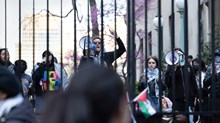Since the earliest centuries of the church, Christians have been translating the Bible into new languages. Yet by 1900, only 404 languages—fewer than 7% of the world's languages—had at least some portion of Scripture. Translation tended to be the work of a few trained experts who spent decades working on one language, and ordinary men and women often could not understand the translations they produced.
The situation at the beginning of the 21st century is very different, thanks in large part to the pioneering work of two men. Cameron Townsend and Eugene Nida developed new approaches that greatly increased the number of Bible translations and made those translations easier to understand.
Training translators
In 1943, Cameron Townsend founded what has become the world's largest missionary organization, Wycliffe Bible Translators. Yet Townsend did not start his missionary career intending to found an organization or to translate Scripture. In 1917, the 21-year-old Townsend went to Guatemala to distribute Spanish Bibles. Sales were slow. Many of the people he met were Cakchiquel Indians who did not know Spanish.
Townsend believed that the Cakchiquel needed a Bible in their language. But there was one problem: the Cakchiquel language had no written alphabet. Rather than abandon the project, Townsend and his wife Elvira spent the next 10 years studying the language, creating an alphabet for it, and, with the help of native speakers, producing a Cakchiquel New Testament.
Townsend had discovered a new calling: translating the Bible into the world's unwritten languages. Because he knew that one person working alone would not make much progress, he decided to teach other people how to analyze unwritten languages and create alphabets for them. In 1934, he held a Summer Institute of Linguistics in Arkansas. Two students came to learn about language analysis and translation. The next summer, five students came.
Townsend continued the Summer Institute and alternated his time between Mexico, where he was using his techniques, and the United States, where he and other instructors were creating a cadre of trained translators. By 1943, he had established two related organizations: The Summer Institute of Linguistics (now SIL International) focused on training and teaching, while Wycliffe Bible Translators (WBT) emphasized translation, evangelization, and service.
Getting the meaning across
Eugene Nida was an early Summer Institute participant. Nida came from a multi-lingual family and was fascinated by languages. After graduating from UCLA with a major in Greek in 1936, he spent the summer at Townsend's institute and then traveled to Mexico to join SIL's work among the Tarahumara Indians.
Townsend recognized a born talent. "Nida," Townsend wrote, "is a genius linguistically." Nida's time in Mexico proved short but significant. Although health problems forced him to return to the United States, he came back with a commitment to using his skills to make the Bible available and easily understood. He earned a Ph.D. in linguistics and in 1943 began working for the American Bible Society. By 1946, Nida was the Executive Secretary for Translations—a job he held until he retired in 1980. He also remained involved with SIL, returning every summer between 1937 and 1953 to teach.
Nida traveled all over the world working with Bible translators and Bible societies. By 1952, he had been to more than 30 countries and encountered more than 80 languages. His experience convinced him that translators needed help making the Bible more accessible. Most linguists translated as literally as possible from the Bible's original Greek and Hebrew, often using words and phrases that made little sense in the new language.
Nida wanted the Bible to be translated faithfully, but he also wanted it to be translated clearly. Eventually he proposed a new theory of translation called Functional Equivalency. Translators should find words and phrases in the new language that conveyed the same meaning as the original Greek and Hebrew, he argued, but the best translation might not be a word-for-word translation.
For example, when translating Mark 1:4 into contemporary English, Nida suggested clarifying a complicated phrase. The verse, translated literally, said that John the Baptist had preached "a baptism of repentance for the forgiveness of sins." Nida claimed that many people would not understand. He suggested putting the same meaning into a more accessible sentence structure: "John preached, 'Repent and be baptized, so that God will forgive the evil you have done.'"
Millions of Bibles
It soon became clear that Townsend and Nida had different gifts and different, though related, missions. Townsend remained focused on the work of translation, motivated by the thousands of language groups still lacking a Bible. Even after he returned from the field in 1968, he still traveled widely, consulting on translation projects in places like the U.S.S.R. and Pakistan. After his death in 1982, SIL and WBT continued the work he began. By 2007, SIL and WBT had trained almost 40,000 linguistic students, had translated the New Testament into 721 languages, and were working on translations in another 1,415 languages.
As head of translation for the American Bible Society, Eugene Nida oversaw one of the most important English translation projects of the 20th century: Good News for Modern Man. This Bible, first published as a New Testament in 1966 (the Old Testament followed in 1976), used Nida's Functional Equivalence Theory to make Scripture more accessible to contemporary readers. Some people estimate that the Good News Bible has sold more than 200 million copies.
Cameron Townsend and Eugene Nida changed the face of Bible translation. Today, people throughout the world have access to Bibles in their native language, in words they can understand, because of the faithful lives of these two men.
Sarah E. Johnson is assistant professor of religion at Gustavus Adolphus College in Saint Peter, MN.
Copyright © 2009 by the author or Christianity Today/Christian History & Biography magazine.
Click here for reprint information on Christian History & Biography.

Support Our Work
Subscribe to CT for less than $4.25/month




























